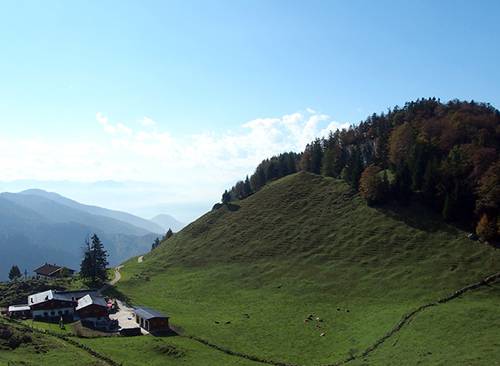This is an old revision of the document!
Table of Contents
Biomass production from grassland
In the Alps, the proportion of grassland accounts for 18 % of the land cover. (Mann 2013, p. 105)1 . Traditionally, grassland is the basis for forage farming owing to local condition like e.g. harsh climate and slope steepness. Due to structural change of agriculture in the Alps, the supply of biomass production from grassland is influenced e.g. by the use of fertilizers and selection of forage plants. Grassland formations range from intensively managed pastures in the valley bottoms to extensive meadows and Alpine swards upwards the altitudinal belt. Location factors like temperature, soil and radiation have a significant impact on the productivity. Grassland ecosystems can provide multiple ecosystem services: According to CICES2 classification, there are three categories for the provisioning ecosystem service “biomass”, namely nutrition, material and energy. Depending on the use of the biomass, the service can be described in dry matter per hectare or energy content per amount of dry matter.
Indicators
As proposed by Burkhard et al. (2014, p. 6)3 , ecosystem service can be described upon their supply, demand and flow. Within the AlpES project the provision dynamics of the ES biomass production from grasslands biomass production from grassland in the Alps were assessed by means of the following supply, demand and flow indicators.
- Supply (status):Gross fodder production (t DM ha-1 )
- Flow:Net fodder energy content (MJ NEL ha-1 )
- Demand: Feed energy requirements (MJ NEL ha-1 )
Further information on indicators can be found here.
AlpES Biomass Production Supply Mapping
In the AlpES project, five different grassland types derived from the CORINE classification are mapped: 1. Intensive pastures, 2. Extensive pastures, 3. Natural grassland, 4. Grassland with shrubs and single trees, 5. Heathland. The Supply of biomass production is calculated according to the “Almbewertungsmodell” as proposed by Egger et al. (2004)4 . Here, each grassland type is connected to a growth function, which represents the yield in DM per Ha and year. The Alpine space is described by seven climatic zones to derive the regional growing season length. Furthermore a new growth function for intensively managed pastures was developed by analyzing livestock intensities per municipalities. For validation of the modelled results empiric measurement data from the Alpine space was collected and applied.
AlpES WebGIS Link
The AlpES Project quantifies and maps the ES of biomass production of grasslands for the Alpine Space. These maps, demonstrating the distribution biomass production, will be located here.
Additional Resources
1) Mann, S. (2013). The future of mountain agriculture. S. Mann. Heidelberg [u.a.], Heidelberg [u.a.]: Springer. Stefan Mann ed.
2) CICES classification
3) Burkhard, Benjamin, et al. “Ecosystem service potentials, flows and demands-concepts for spatial localisation, indication and quantification.” Landscape Online 34.1 (2014): 1-32.
4) Egger, G., et al. (2004). GIS-gestützte Ertragsmodellierung zur Optimierung des Weidemanagements auf Almweiden. Irdning, Irdning: BAL.
Related Projects
Grêt-Regamey, A., et al. (2008). “Linking GIS-based models to value ecosystem services in an Alpine region.” Journal of environmental management 89(3): 197-208.
Tschanz, Ursina. (2011). Schätzung des Ertragspotenzials der Glarner Alpgebiete : Validierung eines GIS-basierten Faktorenmodells. Zürich: Geographisches Institut der Universität Zürich.
Tasser, Erich, et al. “Wir Landschaftmacher.” Vom Sein und Werden der Kulturlandschaft in Nord-, Ost-und Südtirol. Athesia, Bozen (2012).
